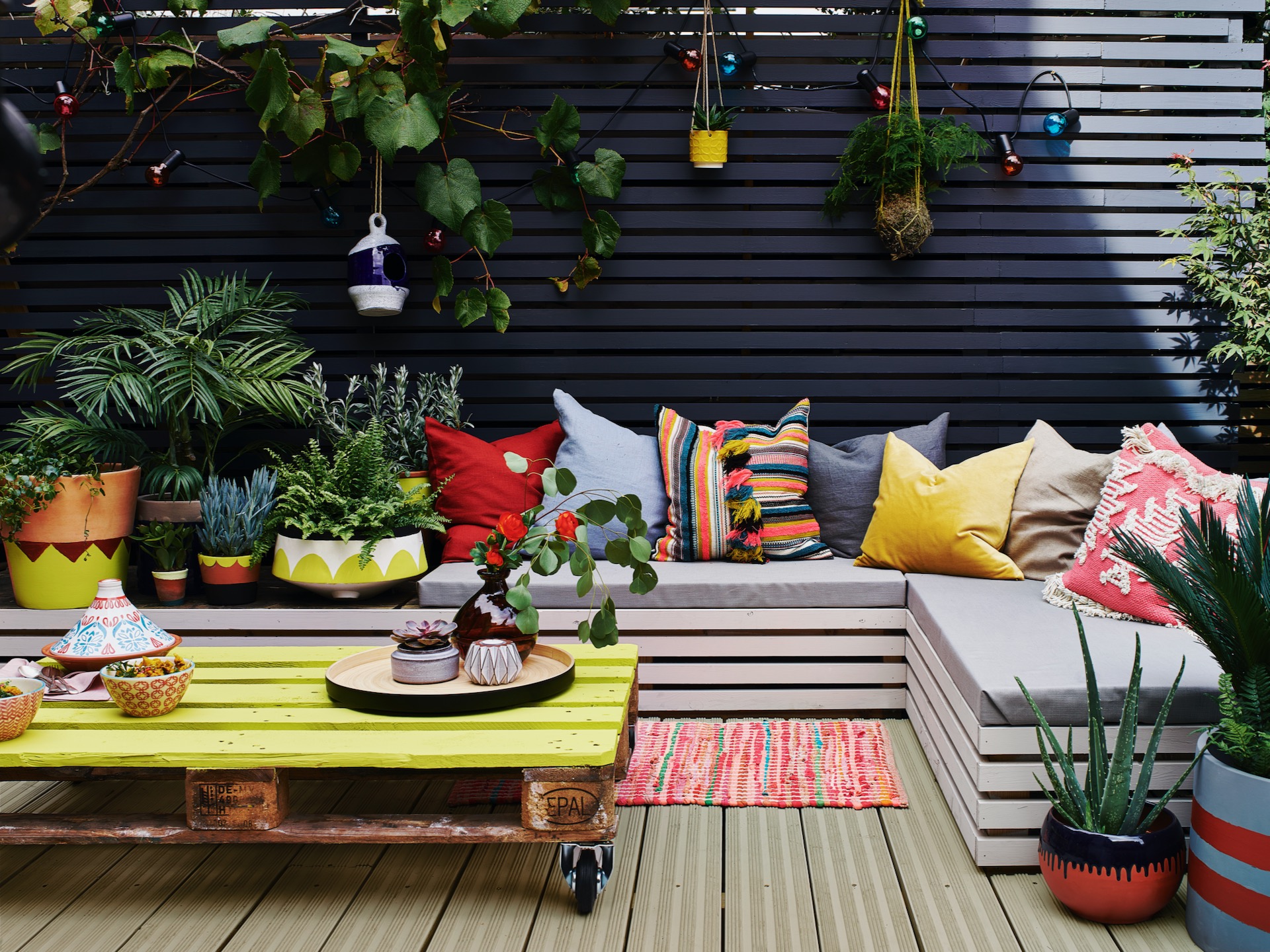
Cuprinol Garden Shades in Urban Slate, Muted Clay, City Stone and Dazzling Yellow
8 fence covering ideas to disguise ugly wooden or metal panels
Replacing garden fences can be a costly affair. So if yours are looking a bit tatty, trying out some fence covering ideas can be a good way to improve things quickly on a budget.
And in many cases, they could look more attractive that another set of plain panelling.
According to Checkatrade, replacing fencing can set us back anywhere from from £1,450 for 4ft fences, to £1,850 for 6ft fences.
Whereas our ideas can cost from just a few pounds for tins of paint – or even for free if you have generous friends and neighbours prepared to provide you with a few plant cuttings.
These fence coverings also invite us to showcase our personal tastes – whether it’s playing around with paint effects, hanging wall art, upcycling an old mirror to hang on your fence or curating a plant wall.
Anything goes. So have fun and take those old panels from past-it to pretty in no time.
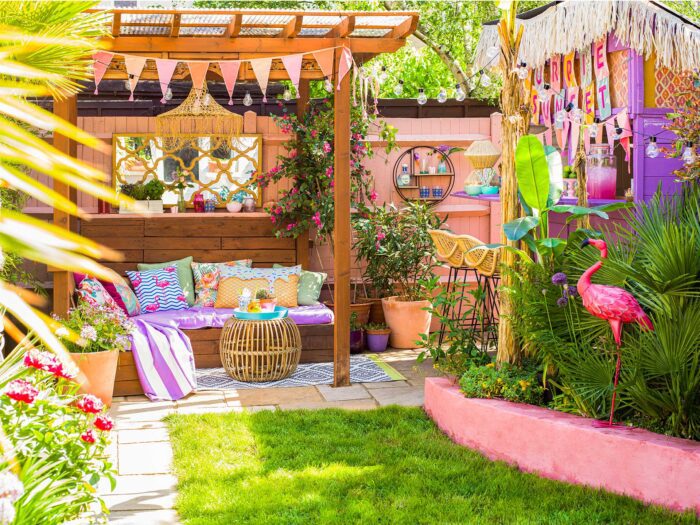
Warning: Before you start, always check with your neighbours and/or your planning deeds to check who owns the fencing and whether all parties are on board with your upgrades.
“Only the owner of the fence may make any changes to it, even where the other side of the fence is on neighbouring property,” says a spokesperson from fencing company Lawsons.
“This means that if you erect a fence in your garden, your neighbour must ask for permission before painting or staining their side of it. Similarly, they may not grow trailing plants up it or any similar activity which may cause it damage.”
This doesn’t apply to your own fence, where you are free to stain and hang things from the fence, provided it doesn’t make the fence unsafe.
Paint your fences in a uniform colour
If your fences are undamaged but looking faded and lacklustre, a lick of paint will instantly transform them.
“There is no one perfect colour for a garden fence – it all depends on the mood you want to create, the size of space and the kinds of plants you have,” explains Marianne Shillingford, creative director at Cuprinol.
“For practicality and long-lasting good looks, choose a shade of green. It will blend in with the foliage and make the space look bigger – plus darker greens like Old English Green are great for adding a bit of sophistication whist hiding a bit of dirt too.”
Marianna continues, “Pale blues and greens like Sea Grass and Willow also make small spaces look bigger and fill the space with a breezy freshness, which is perfect for young families who like to spend lots of time outdoors.
‘Darker shades like Iris and Summer Damson make all plants look amazing (even weeds…) and earthy stones and creams add a classic cottage garden feel that never goes out of fashion.”
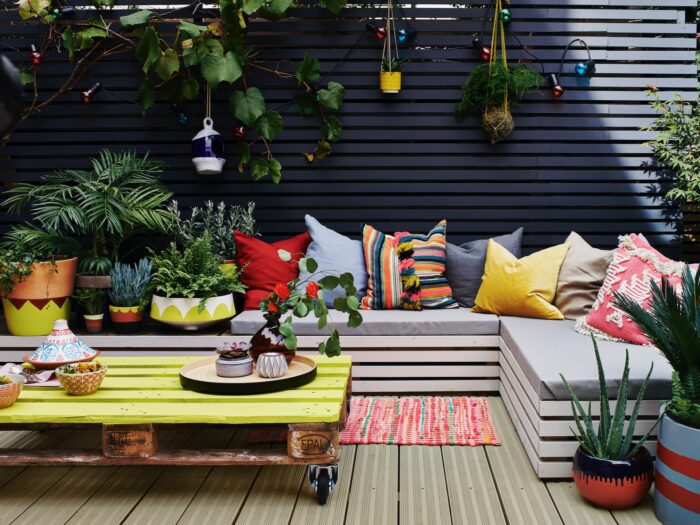
Pale shades reflect light, while white and cream make small gardens look bigger.
“But strangely so does black, which makes the borders of your space visually melt away,” Marianna notes.
Fence covering ideas: nurture a living wall
Again, if your fence is in good enough condition, it may well be able to support a living plant wall.
This can often supplement a paint job, as this example from Dobbies demonstrates.
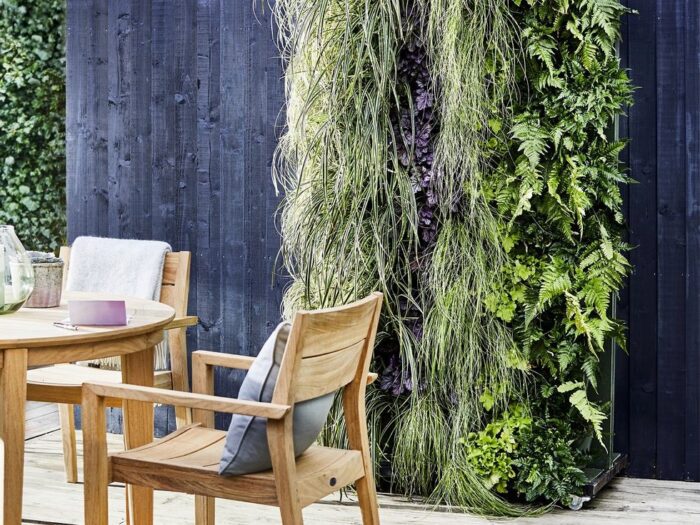
“By bringing your fences to life with pots of pretty plants, you can take a boring and dull small space, and turn it into a thriving and lively green oasis,” says Patty Willems, PR manager of sustainable plant pot creator Elho.
“Not only are living walls beautiful to look at and create a wonderful green view, but they also serve many benefits such as deflecting water, and providing food and shelter for local insects and pollinators – all while contributing to improved air quality.”
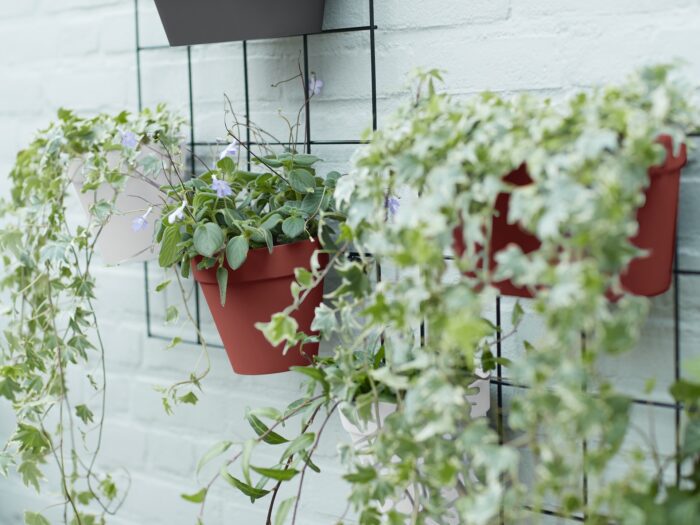
“There are many ways to get growing vertically,” Patty adds.
“Pallets and old tin cans make for a rustic and thrifty look, or you can find many space-saving solutions in the garden centre.
“Our green wall rack simply fixes to a wall or fence. You then fill the pots with your favourite flowers and trailing plants, or even add a selection of herbs to create a hanging herb garden.
Climbing species like wisteria, jasmine and clematis are popular options, and will soon scale walls to offer a burst of colour and sweet floral fragrance.
Shop the look: Loft Urban Green Wall collection, from £2.79, Elho
Screen with trees or hedging
Planting trees and shrubs in front of fencing is another easy screening solution.
It’s logical to choose fast-growing species for quick coverage, but be careful.
Trees can have far-spreading roots that could disrupt fence posts, and bamboo, while great for screening, can be extremely invasive and disruptive if you choose the wrong species.
If you love bamboo, it might be more sensible to grow it in pots and position it in front of the fence.
Or you could choose a Fargesia rufa – a clumping bamboo also known as fountain bamboo, which won’t spread excessively.
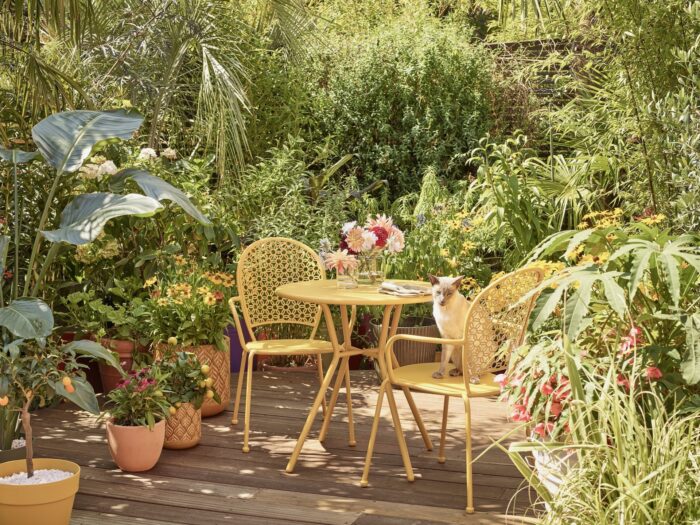
Fence covering ideas: add climbers
“Climbing plants can completely transform fences, creating stunning backdrops and vertical
interest in all types of gardens,” plant expert, writer and TV presenter Sarah Raven tells us.
“Clematis armandii ‘Snowdrift’ is one of my favourites for covering a fence thanks to its sweetly scented, cream-coloured petals.
It’s a variety that’s truly hard to beat with stunning star-shaped flowers that bloom from April to May when positioned against a fence in full sun.”
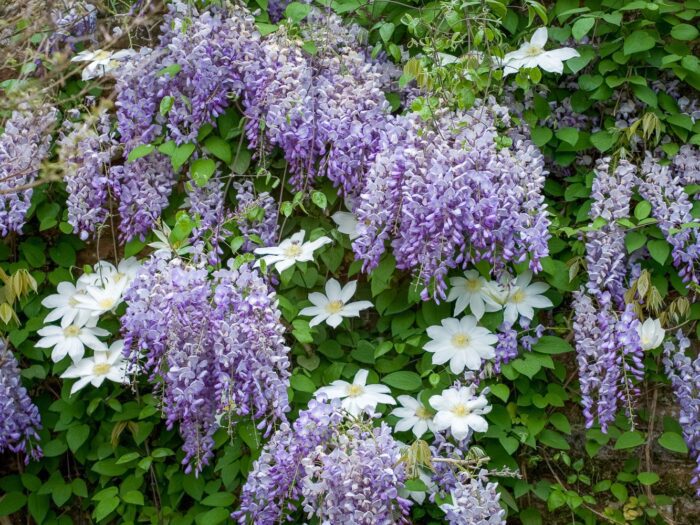
“There aren’t many better options than the prolific flowering Ipomoea purpurea ‘Grandpa Ott’
also known as Morning Glory,” Sarah continues.
“Its striking purple flowers bloom happily throughout the summer and early autumn, which is brilliant for concealing fences. It’s easy to grow in most soils when positioned in a light location and watered frequently.
“Finally, you can try Clematis alpina ‘Frances Rivis’. This is a spring-flowering clematis that
will cloak an entire fence with ease.
‘The vivid purple blooms and rich cream staminodes
create a wonderful contrast that suits so many gardens.”
It’s easy to care for, requiring a simple tidy-up after flowering in mid to late spring.
Fence covering ideas: hang an outdoor mirror
The joy of using a garden mirror to cover a fence is that it can improve your outdoor space in several ways.
Not only does it make a small garden feel bigger, but it can also direct light into particularly dark areas and catch the reflection of your favourite plants.
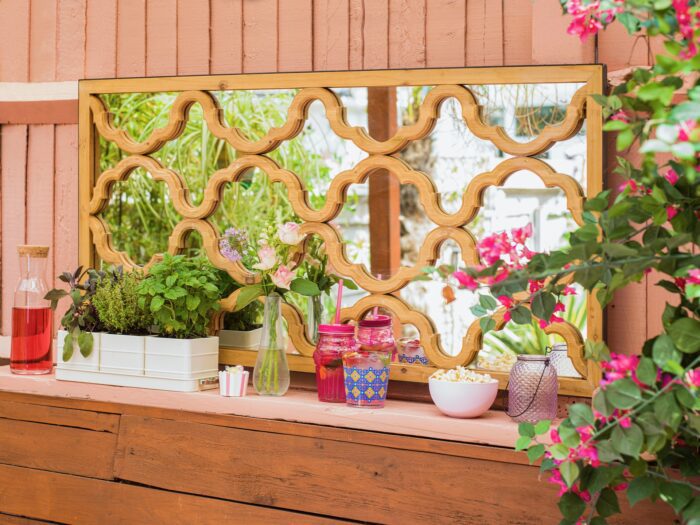
When shopping for your mirror, ensure it has a finish that will withstand the elements.
Powder-coated steel is a good option, or you could use a wooden frame treated with a protective paint or stain – a good way to upcycle an old indoor mirror.
You could also treat the glass with Turtle Wax – this will repel rain water and keep it cleaner for longer.
Use panels or screening
The next way to update a dull old fence is to use decorative panels.
We’re a fan of Charles & Ivy’s designs, as they are made of a blend of recycled wood powder and recycled polyethylene, and can easily be screwed or even glued into place.
“They’re an easy and quick way to transform a space,” says Danya Taylor at Charles & Ivy.
“They can be used for decoration, or a replacement for your typical garden trellis for climbing plants; they’re also weather resistant, have longevity, and require minimal upkeep.
We even provide the options of having mirrored and bespoke size screens, so you can make your space unique to you.”

Alternatively, you could have fun creating your own wall art with strips of wood or metal, as seen in the The Panathlon Joy Garden designed by Penelope Walker at RHS Chelsea Flower Show 2024.

Fence covering ideas: build a bug hotel
Got any wooden pallets, bricks or wooden crates lying around?
You could build them up in front of your fence to create a sustaining bug hotel – a refuge for all sorts of wildlife.
“Divide it into sections and stuff each part with different natural materials,” advises The Woodland Trust.
“Dry leaves, twigs, hollow stems, dead grass, pine cones and bits of bark are ideal. They’ll help to create warm, dry spaces that will attract different creepy crawlies.”
This will attract ladybirds, bees, frogs and even hedgehogs.
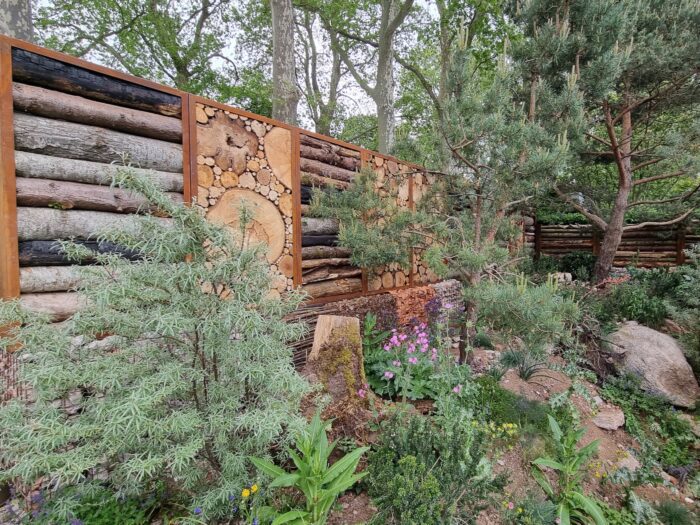
The great things about a bug hotel are that you can go as big (or small) with it as space allows, the kids will love them, and they can look surprisingly beautiful, as the above proves.
Go for a multi-colour effect
This last idea isn’t one for the faint-hearted, but it is a chance to have a lot of fun.
You can either paint your existing fence, or clad it with extra materials to make it more robust.
This in turn offers you a chance to play with dimensions and texture, as seen in this garden – the RHS Chelsea Repurposed garden from the 2024 Flower Show.
It features fencing covered with reclaimed scaffold boards and timber from a previous show garden –Cityscapes’ 2022 St Mungo’s Putting Down Roots Garden.

Matthew Brown, Sadolin & Sandtex technical consultant, recommends that you choose tonal shades rather than clashing colours when adopting this approach.
“A number of clashing brights could end up looking jarring and will eclipse all the other features in your garden,” he says.
“Remember, you want your garden fence colours to enhance your space, not detract from it.”
Three tips for maintaining your garden fencing
Don’t pressure wash
“You should avoid pressure washing your garden fences, as satisfying as the results may look,” says Dr Jonathan Kirby, expert at garden weatherproofing provider Roxil.
“The high-powered spray can damage wood fibres, causing splintering. This can make the rate of moisture ingress worse and reduce the lifespan of wooden items by introducing rot, warping, mould and algae.”
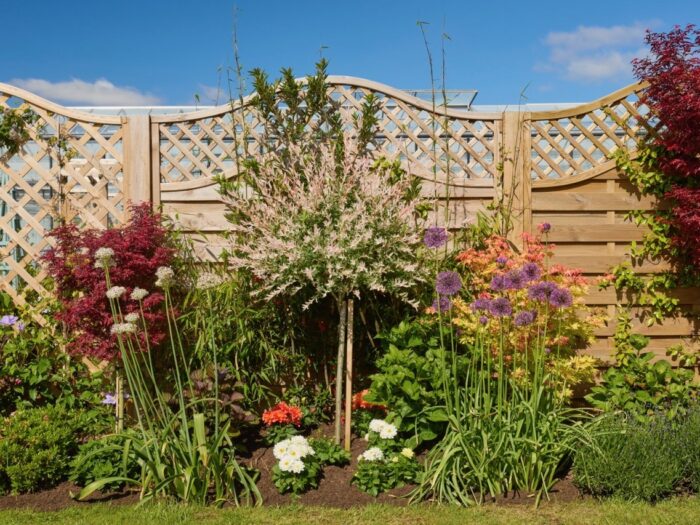
Inspect, treat and clean the wood before you start painting or staining
“Inspect for any damage you may need to fix or treat like woodworm,” adds Jonathan.
“Use a stiff wooden brush to brush away any loose debris from the area that you want to treat.
“Then, choose your cleaner but watch out for acid or bleach-based cleaners as these can damage the surfaces and be corrosive to the skin, and instead opt for a soft, non-destructive cleaner.”
Waterproof the surface
“To protect your fence from future growth, once it’s clean, it’s time to waterproof surfaces,” Jonathan says.
“Make sure the surface is completely dry before applying small amounts of a protective sealer, like Roxil Wood Protection Cream, directly to the surface using a brush or roller, and leave it to absorb into the surface for 24 hours.”
READ MORE:





